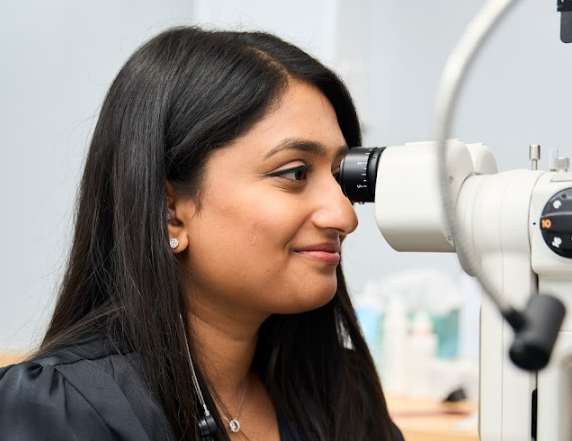Blog:Eye Exams Explained: What's Included in a Full Check-up

Unlock the details of a comprehensive eye exam. Learn about vision tests, health assessments, and more!
Your eyes show you the world, but have you ever wondered what happens during an eye check-up?
Imagine sitting in the eye doctor's chair, surrounded by high-tech tools and a friendly expert looking after your eyes. The tests they perform reveal how your eyes work and why it's important to get checked regularly.
It's not just about technical stuff; it's a chance to learn how to take care of your vision, from adjusting lighting to using the latest treatments.
Today, let's explore together and learn how to keep our eyes healthy, one check-up at a time. We'll discuss what happens before, during, and after the eye exam, uncovering the steps to maintain optimal vision and eye health.
Let’s begin!
Preparing for the Exam
#1 Get Ready for Your Eye Appointment
A successful eye exam starts with proper preparation. Begin by writing down any vision concerns or symptoms you've been experiencing, such as blurred vision, eye strain, or floaters.
Gather your current eyeglasses or contact lenses, as your eye care professional will need to evaluate their fit and prescription accuracy. Being well-rested and arriving with any necessary paperwork or insurance information can also help ensure a smooth appointment.
#2 Age Is Just a Number, But Your Eyes Need a Check-up Calendar
The frequency of eye examinations can vary based on age and the presence of certain risk factors.
Children, adolescents, and adults, even without vision problems or risk factors, should have annual eye exams to monitor vision development and eye health.
However, those with conditions like diabetes, high blood pressure, or a family history of eye diseases may require more frequent evaluations, as advised by their eye care provider.
#3 Choosing the Right Eye Care Professional
Finding the ideal optometrist involves assessing their qualifications, experience, and proximity to your location. Patient reviews are valuable for understanding their expertise and the level of care they offer.
Consider these factors to select the perfect eye care professional tailored to your requirements.
The Eye Exam Process
#1 Understanding Your Vision Test
During your eye exam, your vision will be thoroughly assessed through a series of tests. One of the most familiar tests is the visual acuity test, where you read from an eye chart to see how well you can see at different distances, helping detect nearsightedness or farsightedness.
The refraction test goes further, using a phoropter to determine the precise lens prescription needed to correct your vision. Your eye doctor will guide you through different lenses to find the best fit for you.
Additionally, color vision may be checked by identifying patterns or numbers made of colored dots to detect any color vision issues.
#2 Eye Coordination Assessment
During your eye exam, your eye doctor will also assess how well your eyes work together to focus and move. One test they may perform is the cover test, where they cover each eye individually while you focus on a target. This helps detect any alignment issues like strabismus (crossed eyes) and ensures proper eye coordination.
#3 Evaluating Eye Health
In addition to checking your vision, a significant part of your eye exam is dedicated to assessing the overall health and function of your eyes.
The pupil reaction test ensures that your pupils respond correctly to changes in light, while the slit-lamp microscope allows your doctor to closely examine the front parts of your eye for any irregularities.
Tonometry measures inner eye pressure, crucial for detecting conditions like glaucoma. After dilating your pupils with drops, your doctor can thoroughly examine the back of your eye for signs of diseases such as macular degeneration or diabetes-related damage.
Observing your eye movements as you follow objects helps assess coordination and tracking skills essential for activities like reading.
These assessments are vital for diagnosing conditions affecting eye health and function beyond basic vision testing.
Tonometry measures inner eye pressure, crucial for detecting conditions like glaucoma. After dilating your pupils with drops, your doctor can thoroughly examine the back of your eye for signs of diseases such as macular degeneration or diabetes-related damage.
Observing your eye movements as you follow objects helps assess coordination and tracking skills essential for activities like reading.
These assessments are vital for diagnosing conditions affecting eye health and function beyond basic vision testing.
Post-Exam Care
1 Explaining Your Results and Diagnosis
After your eye exam, your doctor will explain the findings and diagnosis in simple terms. They will discuss any issues detected, such as nearsightedness or astigmatism, and explain how this impacts your vision.
#2 Exploring Treatment Options (if Necessary)
If treatment is needed, your eye doctor will discuss various options, such as prescription glasses, contact lenses, or potential therapies for specific eye conditions. They will explain the benefits and help you choose the best approach for your needs.
#3 Planning Follow-Up Appointments and Recommendations
Lastly, your doctor will schedule any necessary follow-up appointments and provide recommendations for maintaining or improving your eye health. They might suggest lifestyle changes, eye care practices, or further tests to monitor your vision over time.
Final Thoughts
Taking care of your eyes is crucial for keeping your vision sharp and your eyes healthy. Regular eye exams are the key to making sure everything is working properly.
If it's been a while since your last full eye check-up, now is the perfect time to book an appointment. Don't put it off any longer!
Head over to TSO Champions at 5774 Cypress Creek Parkway in Houston. Our optometrists there will give your precious eyes the attention they deserve.
Let's get your eyes back in tip-top shape so you can enjoy clearer, more vibrant vision and appreciate all the beautiful sights life has to offer!



